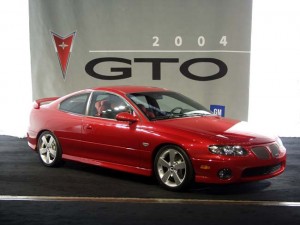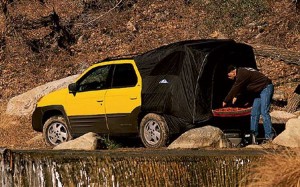It’s a cliché we seldom think twice about, but when workers at the General Motors’ Orion Township assembly line finished up a white G6 sedan, just before the long holiday break, last Wednesday, it really was the “end of the line.”
More than a century after the first time the name of the powerful Michigan Indian chief was used on a car – and 83 years after GM formally adopted the brandname – the last Pontiac automobile was getting ready to be shipped to a dealer.
There were no banners commemorating the event, nor the black crepe bunting that might have more appropriately served to mark the sad occasion. It was little more than business as usual. Or, if you prefer, business as it’s become for post-bankruptcy General Motors.
For more than a decade, the automaker’s top management, notably former CEO Rick Wagoner, forcefully resisted calls to kill Pontiac and several other troubled GM brands in a bid to curb expenses and focus on the core marques most likely to survive. They had given in just once, and the long and costly process of killing off the once-successful Oldsmobile had proved so hard, Wagoner confided in a close friend, “I never want to go through that again.”
But that was before the bottom fell out, before financial collapse began looming in GM’s rearview mirror, forcing the automaker to go begging for a federal hand-out. Their initial proposal called for selling off three of the company’s eight North American brands: Saturn, Saab and Hummer, keeping Pontiac around for specialty products, perhaps like the Solstice roadster that had garnered it so much attention earlier in the decade.
But the hot little concept 2-seater did little to fix the brand’s bottom line, and it became increasingly clear that Pontiac would have to go, as well. But while GM hoped to sell the other three brands, it didn’t even offer a reprieve to a marque that long boasted, “We build excitement.”
Could anyone have really ignored the steady decline? And could GM have saved Pontiac if it had just tried a little harder, a little earlier?
The Pontiac nameplate first appeared in 1900. Commemorating a Michigan Indian chief who led an unsuccessful uprising against British settlers, it was the product of the Pontiac Spring & Wagon Works which, eight years later, merged to become part of the Oakland Motor Car Company.
The name reappeared in 1926, at the New York Auto Show. Oakland, by then, was one of an expanding line-up of brands operated by General Motors, part of legendary CEO Alfred P. Sloan’s strategy of producing “a car for every purse and purpose.” Sloan crafted a sort of ladder-like hierarchy, allowing increasingly affluent Americans to steadily trade up brands; if they were successful enough, they might ultimately climb up from a Chevrolet into a Cadillac.
But in the years between the Wars, each better-known brand also had a more affordable, companion marque. For Cadillac, it was LaSalle. For Oakland, it was Pontiac, which launched the straight-6 Pontiac Chief in 1927. The car proved so successful that when GM eventually abandoned the companion brand strategy, Pontiac was the only one of the less-expensive marques to survive.
The brand’s fortunes repeatedly rose and fell over the decades, but in 1956, a new management team led by Semon “Bunkie” Knudsen took over. Among his top lieutenants was a maverick strategist by the name of John De Lorean. They energized the brand, launching models like the original Bonneville, a runaway hit, even though it cost as much as a Cadillac.
By 1965, Motor Trend magazine was ready to give the brand its third coveted Car-of-the-Year award – but this time for the entire Pontiac line-up.
Late at night, it was common to see top Pontiac executives, including De Lorean and marketing chief Jim Wangers, driving up and down Detroit’s central Woodward Avenue, talking to the kids who were providing the big new market for muscle cars, Wangers recalls, occasionally rolling out a new model, or fielding a prototype to see how it would fare against the likes of the new Ford Mustang or Plymouth Barracuda.
“We Build Excitement,” the Pontiac ads declared, and products like the GTO and, later, the Firebird, defined the breed.
But in the wake of two oil shocks, Pontiac suddenly couldn’t decided what to build. Like the other General Motors brands, it struggled with nearly identical econocars, like the 6000, and saw a steady decline it its customer base.

The reborn, 2004 Pontiac GTO couldn't deliver on its promise, with styling and performance that fell short of expectations.
By the late 1980s, when the soon-to-be-abandoned 6000 sedan won a rare quality award based on customer surveys, former general manager John Middlebrook told me it was because “They don’t know any better.” The only ones still buying Pontiacs, he lamented, were older domestic diehards who didn’t realize how much better the imports had become.
Over the last decade, Pontiac tried everything it could think of to turn things around. Before the arrival of crossover-utility vehicles, it had fielded a series of intriguingly flexible concept cars, one of which Middlebrook likened to “the Swiss Army knife of cars.” But when the marque finally got approval to put concept into production, it came up with one of the most reviled cars of recent decades, the abortive Aztek, frequently considered among the ugliest cars ever built.
Even an attempt to regain the image as GM’s “excitement” brand missed the marque when the legendary GTO – or “Goat,” as aficionados preferred – reappeared, in 2004. It had a soft bland shape and, initially, was short on power.
By then, nothing seemed to work, even the Solstice, a pet project of GM “car czar” and Vice Chairman Bob Lutz.
At its peak, in 1984, the marque sold 850,000 cars. Sales in 2008 were barely a quarter of that and by next year, as Pontiac and its dealers are phased out, the marque will barely even register on the charts. It will join scores of other names, some revered, some not, including Olds, Oakland, Saturn, Plymouth, Stutz, Packard Maxwell and American Motors, on the rust heap of the American auto industry.

